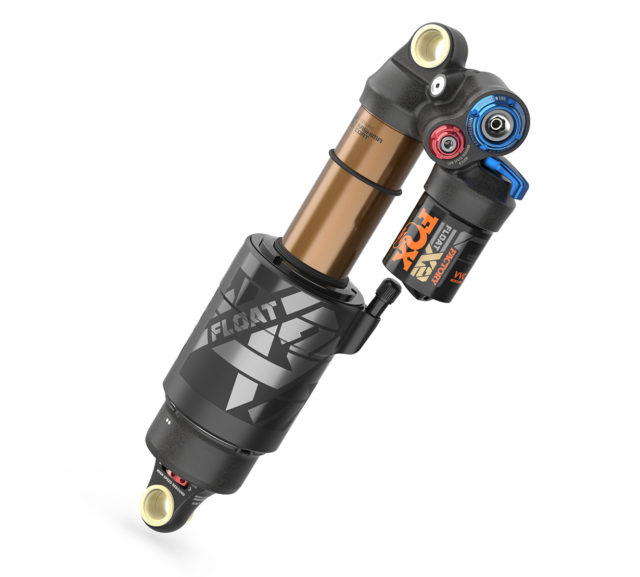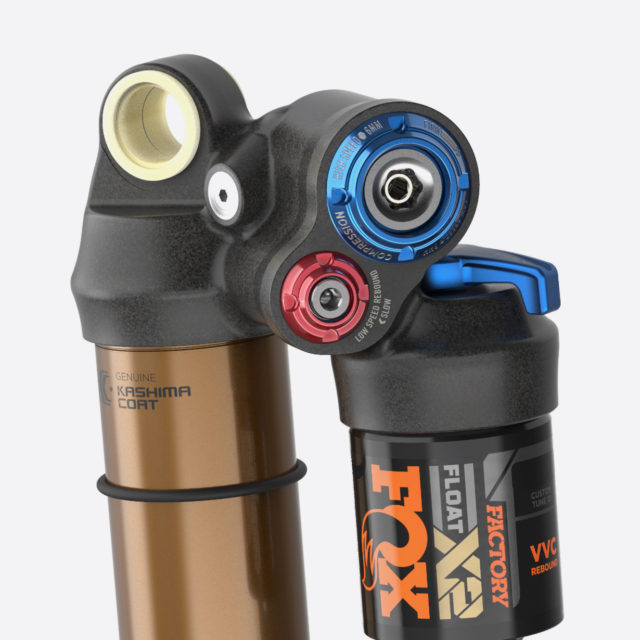2021 Fox Float X2 Shock
Test Location: Montana
Test Duration: ~2 months
Version tested: 205 mm x 60 mm Trunnion Mount
Blister’s Measured Weight: 666 grams (🤘)
MSRP: $669 as tested
Bolted to: Specialized Enduro
Reviewer: 5’9”, 155 lbs

Intro
The Fox Float X2 has been a benchmark for downhill-oriented air shocks for quite some time. While it’s not the only downhill-oriented air shock on the market, I’d argue that it’s the best option from the major manufacturers for those seeking coil-like performance out of an air shock.

For 2021, Fox redesigned both the coil-sprung DHX2 and air-sprung Float X2 from the ground up. I’ve spent the last two months on the 2021 Float X2 aboard my Specialized Enduro, getting a feel for the new unit, and comparing it to the previous generation.
Options / Specs
The Float X2 is available in an assortment of imperial and metric sizes, including standard trunnion mount sizes. Some sizes are available without the lockout lever.
- Imperial sizes, with lockout lever: 7.875 x 2.0 / 8.5 x 2.5
- Metric sizes, with lockout lever: 210 x 50 / 210 x 55 / 230 x 57.5 / 230 x 60 / 230 x 65
- Trunnion Metric sizes, with lockout lever: 185 x 50 / 185 x 55 / 205 x 60 / 205 x 65
- Imperial sizes, without lockout lever: 9.5 x 3.0 / 10.5 x 3.5
- Metric sizes, without lockout lever: 250 x 75
- Trunnion Metric sizes, without lockout lever: 225 x 75
All models have 8 clicks of high-speed compression adjustment, 16 clicks of low-speed compression adjustment, 8 clicks of high-speed rebound adjustment, and 16 clicks of low-speed rebound adjustment.

Aftermarket Float X2’s are only available in Fox’s “Factory” trim (with Kashima coating). Presumably, we may see OEM spec’d 2021 Float X2 shocks come on some bikes in a Performance Elite variation (which is functionally identical, aside from the Kashima coating).
What’s Different?
Quite a bit — the X2 shocks (both the DHX2 and Float X2) saw significant revisions for 2021. Visually, the Float X2 looks roughly similar to the old version, but internally, it’s a different beast.
To start with, the 2021 Float X2 gets a new chassis. The reservoir is shorter (which means it’ll fit on more bikes and interfere with fewer bottle cages); the lockout lever is longer and easier to flip without looking; and the high-speed rebound damper adjustment is now at the opposite end of the shock.

That change in the position of the high-speed rebound damper is due to one of the biggest changes in the shock — the switch to Fox’s Variable Valve Control (VVC) damper. The VVC rebound damper in the new X2 shocks (and also found in some of Fox’s 2021 forks) handles the high-speed rebound circuit in a new and fairly novel way.
Rather than churning out 2000 words trying to hack my way through an explanation of the VVC damper, here’s Fox’s Jordi Cortes laying it out nicely. He’s speaking in the context of a GRIP2 damper in a Fox fork, but the same basic principle applies to the rear shocks.
While the VVC system is a marked departure from the Rod Valve System (RVS) used in the prior generation of the Float X2, the RVS-style, spring-backed shim stack is still used for the 2021 Float X2’s high-speed compression. And both the low-speed compression and low-speed rebound adjustment remain a relatively simple, adjustable needle valve (which essentially closes off a port that the oil flows through as more damping is added via the external adjustment). But while the low-speed adjustments and high-speed compression remain structurally similar to the prior generations of the Float X2 shock, all of those damping circuits have seen some tweaks in this new version.
The damper is also changed with respect to the lockout lever — internally, the lockout is now independent of the compression circuits. This means that moving the lockout lever doesn’t actually affect the shock’s normal damping circuits at all — the lockout has its own valving. This helps achieve a solid lockout without messing with the damper’s performance.
Beyond those bigger structural changes, there is also a slew of smaller changes that we’re somewhat accustomed to seeing in suspension revisions. Those are things like lower-friction seals, lower-friction coatings on the damper shaft (that’s the internal shaft, not the external, Kashima-coated lower body), tweaks to the bottom-out bumper, and, of course, new graphics.
Do the Differences Make a Difference?
In a word, yes.
I mounted the 2021 Float X2 on my Specialized Enduro, which came stock with a 2020 Float X2. So I had the ability to swap back and forth between the old Float X2 and the new one to really feel how the two compared.
As a baseline, the 2020 Float X2 was a great shock. As I said at the outset, among the air shocks on the market, it’s high on the list of shocks that come close to mimicking the upsides of a coil shock. That said, I found I had to run the low-speed compression fairly open to achieve the sort of ground-hugging, ultra-traction-y feel that I wanted out of the Enduro, and it was a bit difficult to find the right balance between small-bump sensitivity and support. I had to choose one or the other — it was hard to get the shock to feel nicely supportive through berms and off jumps without making it feel a little harsh on small chatter. (And just to reiterate, I’m talking about the prior-generation, 2020 Float X2 here.)

With that in mind, I mounted up the new, 2021 Float X2 and, to start with, set the damper adjustments the same as the old shock. And pretty much immediately, in the first minute of riding, the difference was noticeable. The rear end tracked every little contour of the ground noticeably better.
Now, this was with relatively little low-speed compression (2 clicks from fully open) and a medium amount of high-speed compression (6 clicks from fully open). And as with the old Float X2, I wanted a bit more support out of the rear end. The big difference here is that, with the 2021 Float X2, I can add significantly more compression damping without getting into that harsh feeling that I was experiencing with the old version.
In the name of testing, I did a few laps at the bike park running through the full range of compression settings on the shock. I ran everything from fully open on both the low-speed and high-speed to fully closed on both, and assorted positions in between. Here are my main takeaways after that:
(1) Fox’s claims that their VVC damper is smoother seems to be backed up by my experience — the shock does feel really, really smooth in most situations.
(2) That said, there are a bunch of changes in the 2021 Float X2, and I have a hard time saying which specific design change(s) the improvements stem from. It’s almost certainly a cumulative effort.
(3) The usable range of the compression damping is significantly larger than the prior-generation Float X2, or pretty much any other shock I’ve ridden in recent memory.
(4) It was only with the high-speed compression near its highest setting (1-2 clicks from fully closed) that I started to feel like the damping was harsh.
The new Float X2’s improvement in the damping also means that I’ve been able to get away with less fussing around with the air spring. On the older Float X2, I spent more time tweaking air pressure and swapping in volume reducers to try to eke out a little more mid-stroke support without killing the small-bump sensitivity. The new Float X2 has let me be pretty lazy about that — I get the air pressure pretty close, and then I can satisfactorily dial in the ride with the damper (which is a lot quicker and easier, and ultimately rides better).

The long and short of all of that is I find I can run more compression damping to provide better support for pumping the bike and better control over medium to large impacts, all while preserving the small-bump sensitivity that gives the bike that glued-to-the-ground feel that’s awesome when you’re fighting for traction.
Now, the 2021 Float X2 still gives up some ground compared to the best coil shocks on the market when it comes to pure suspension performance. But it gives up less ground than ever before — that performance gap has closed by a not-insignificant amount. And, of course, there’s a degree of tune-ability (and weight savings) that you only get with an air shock.
It feels like a bit of a side note, but yes, the lockout lever works well. It’s bigger and easier to flip than on the old version, and the lockout is a touch firmer. I can’t honestly say that I use it all that much, but when I want it, it’s there and it works well.
Issues?
I don’t have much to say here — I haven’t performed any service on the shock, and it’s given no indication that it needs it. When the shock was brand new, it made a very minor “buzzy” sound as it compressed, which I’m guessing was just a slightly imperfect seal somewhere that was being weird during compression. I didn’t notice any performance impact from that, and it went away after a few rides.

My only other gripe is that the switch to the VVC damper requires the high-speed rebound adjuster to be in line with the shock at the air-can end. Depending on your bike’s linkage layout, this can make it tricky to adjust without a pokey thing (technical tool term) to turn the dial. Fortunately, high-speed rebound isn’t something that I’m usually messing with too often — at least for me, it’s mostly set and forget.
Who’s It For?
There are a lot of different options out there for rear shocks these days, and people seem like they’re going in completely different directions with setting up the rear ends of their bikes. On one end we’ve got downhillers running air shocks, and on the other are people putting high-end coils on 120mm-travel Trail bikes.
So where does that leave the Float X2? Purely from a capability standpoint, in Fox’s lineup the Float X2 sits between the more trail-oriented (and excellent) DPX2 and the more downhill-oriented (and also excellent) coil DHX2. And in terms of performance, the Float X2 does indeed split that difference, although the split is maybe tilted more toward the coil / downhill end of that spectrum.
Compared to the DPX2, the Float X2 is more supple and uses its early stroke a little more readily, and (without volume reducers) the larger air can is a little more linear — it ramps up less towards the end of its travel. The Float X2 is also more tunable, offering both low- and high-speed compression and rebound adjustments, compared to the DPX2’s single rebound and single compression adjustment.
Compared to the coil DHX2, the Float X2 is more adjustable (it has the same damper adjustments, plus you can tailor the air spring with volume reducers), and it’s lighter. But ultimately, despite coming pretty close, the Float X2 still doesn’t quite feel like a coil — the level of suppleness you get from a coil is tough to beat when the going gets legitimately rough.
So who should get the Float X2? Someone who wants downhill levels of performance, but either wants the extra tunability of the air shock, prefers the more progressive feel of an air spring, or maybe is just trying to keep the weight semi-reasonable on their Enduro sled.

The people looking to upgrade who will probably gain the most from the Float X2 are people who are trying to eek a bit more performance out of the suspension on their Trail / Enduro bike, but who don’t want the weight, tuning hassle, or inefficiency of a full-blown, coil DH shock. The bump in performance over a DPX2 (or RockShox Super Deluxe, or Cane Creek DBAir) is real — the Float X2 is more tunable, smoother, and is better able to handle extended descents without overheating. It comes with a ~200 g weight penalty (compared to a DPX2), which isn’t insignificant, but that’s still a good bit less than the weight penalty with a coil.
Putting the performance difference between a Trail shock like the DPX2 and a more Downhill-oriented shock like the Float X2 into words is a bit tricky. But really what it comes down to is that, with the Float X2, you can ignore more stuff. The better your rear suspension is, the rougher the trail can be before it matters — you can get away with worse line choices, and you can carry more speed through corners because your bike is going to get a little less discombobulated when you smack into that random root or rock that’s inconveniently placed at the apex of your turn. It’s not a night and day difference (few upgrades are these days), but it’s an incremental change that increases your control on descents, at the cost of some weight and maybe efficiency on climbs and flats.
Bottom Line
Every year, suspension gets better. Sometimes the annual, incremental improvements are barely noticeable. Sometimes they’re pretty clearly better. The 2021 Fox Float X2 falls into the latter category — it rides better, it’s more tunable, and it’s easier to land on a setting that rides well (and conversely, harder to land on a setting that rides terribly).
The Float X2 is still a downhill-oriented shock that’s maybe overkill for a trail-oriented bike. It’s more focused on bump absorption than pedaling efficiency or light weight, though, between its excellent damping adjustments and climb switch, it can certainly be made to work to efficiency’s advantage. But if you want the adjustability (and semi-reasonable weight) of an air shock but want suspension performance that’s about as close to a coil as you can get, the new Float X2 is a damn fine choice.

Hi
has been the x2 2021 damper tested with the stock tune (d5pr) or Rx trail tune?
The 2021 Float X2 I tested had a tune that Fox did for the Enduro – code D3WF. The 2020 Float X2 that came stock on the Enduro had the tune code DXB8.
-Noah
thanks noah, I buy the 2021 with the tune d5pr, but will also tune it up
-René
Thoughts / Comparison to the Push 11-6?
I’m 165lbs riding a 2020 s3 enduro and have struggled badly to get it to feel supple w/ my 2021 x2 Running 220psi and two volume spacers because I’m bottoming out. What compression/rebound and air pressure settings did you run on the x2 for this test? Also curious what you ran the fox 38 at as well.
Thank you
Hey Austin,
I’m running around 175psi in the X2, which gives me about 30% sag. I only weigh a little less than you, so if you’re having to run 220, I wonder if there’s an issue with your shock (or maybe you’re just running very little sag?).
I still fuss around with the compression settings a bit, but I’m running around 5 clicks of LSC, 4 clicks HSC (from fully open), and I don’t recall off the top of my head where my rebound settings ended up, but I think I’m around 3 clicks HSR, 8 clicks LSR (also from fully open / fast).
For the 38, I was running around 83 psi, around 5 clicks LSC, 7 clicks HSC (from fully open). And I don’t recall my rebound settings, but they weren’t crazy – somewhere in the middle, pretty close to what Fox recommends.
-Noah
First I have 2021 fox float x2 how do I open air canister to put volume spacers . And I weigh 208 pounds I ride bikes parks and like a lot of ramp up to clear jumps should I add volume spacers and how many come in it . I have 2021 s works enduro and suggestions on hsc and lsc settings and hsr and let settings
Hi Noah,
Good read here! I have the same shox and it is great so far, the only thing that i couldn’t figure out is the braking bumps part. Any thoughts?
Im 195 lbs rider on a Nomad V5
Fox X2
HSC 4
LSC 11
LSR 12
HSR 3
PSI 210
3 spacers
Hey Noah! Thanks for the review, great one!
I just bought the Fox X2 2022 factory. I will be receiving it in a few days.
I had the 2020 Fox x2 factory. I never thought the shock was missing support, but it definitely was missing small bump sensitivity and traction. I improved that by buying a pair or Cush Cores and reducing psi by 5 each wheel.
The shock itself always felt harsh on chatter and small bumps, and I was never happy with it. How much of an improvement is the new shock in terms of small bump sensitivity and smoothness?
If it improves small bump significantly, it will be a worth while investment for me!
Let me know all about it, please!
Kind regards,
Justin